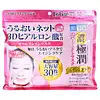What's inside
What's inside
 Key Ingredients
Key Ingredients

 Benefits
Benefits

 Concerns
Concerns

 Ingredients Side-by-side
Ingredients Side-by-side

Water
Skin ConditioningDiglycerin
HumectantGlycereth-26
HumectantNiacinamide
SmoothingMethylpropanediol
Solvent1,2-Hexanediol
Skin ConditioningTrehalose
HumectantPolyglycerin-3
HumectantAmmonium Acryloyldimethyltaurate/Vp Copolymer
Panthenol
Skin ConditioningHydroxyacetophenone
AntioxidantEthylhexylglycerin
Skin ConditioningCaprylyl Glycol
EmollientGlycerin
HumectantC12-14 Alketh-12
EmulsifyingAdenosine
Skin ConditioningSodium Polyacrylate
AbsorbentXanthan Gum
EmulsifyingDisodium EDTA
Butylene Glycol
HumectantHibiscus Sabdariffa Flower Extract
Skin ConditioningTriticum Vulgare Sprout Extract
Skin ConditioningGlycine Soja Phytoplacenta Extract
Skin ConditioningParfum
MaskingCentella Asiatica Extract
CleansingSodium Hyaluronate
HumectantHelianthus Annuus Seed Oil
EmollientCollagen Extract
Skin ConditioningHydrolyzed Collagen
EmollientMadecassoside
AntioxidantMadecassic Acid
Skin ConditioningAsiaticoside
AntioxidantAsiatic Acid
Skin ConditioningPropolis Extract
Skin ConditioningWater, Diglycerin, Glycereth-26, Niacinamide, Methylpropanediol, 1,2-Hexanediol, Trehalose, Polyglycerin-3, Ammonium Acryloyldimethyltaurate/Vp Copolymer, Panthenol, Hydroxyacetophenone, Ethylhexylglycerin, Caprylyl Glycol, Glycerin, C12-14 Alketh-12, Adenosine, Sodium Polyacrylate, Xanthan Gum, Disodium EDTA, Butylene Glycol, Hibiscus Sabdariffa Flower Extract, Triticum Vulgare Sprout Extract, Glycine Soja Phytoplacenta Extract, Parfum, Centella Asiatica Extract, Sodium Hyaluronate, Helianthus Annuus Seed Oil, Collagen Extract, Hydrolyzed Collagen, Madecassoside, Madecassic Acid, Asiaticoside, Asiatic Acid, Propolis Extract
Water
Skin ConditioningGlycerin
HumectantPentylene Glycol
Skin ConditioningPPG-10 Methyl Glucose Ether
Skin ConditioningPEG-240/Hdi Copolymer Bis-Decyltetradeceth-20 Ether
StabilisingHyaluronic Acid/Polyglutamic Acid Crosspolymer
AntioxidantSodium Hyaluronate
HumectantHyaluronic Acid
HumectantHydrolyzed Hyaluronic Acid
HumectantDisodium EDTA
Polysorbate 60
EmulsifyingPhenoxyethanol
PreservativeResveratrol
AntioxidantGnetum Gnemon Seed Extract
Skin ConditioningDextrin
AbsorbentBeheneth-30
CleansingCitric Acid
BufferingAmmonium Acrylates Copolymer
Methylparaben
PreservativeWater, Glycerin, Pentylene Glycol, PPG-10 Methyl Glucose Ether, PEG-240/Hdi Copolymer Bis-Decyltetradeceth-20 Ether, Hyaluronic Acid/Polyglutamic Acid Crosspolymer, Sodium Hyaluronate, Hyaluronic Acid, Hydrolyzed Hyaluronic Acid, Disodium EDTA, Polysorbate 60, Phenoxyethanol, Resveratrol, Gnetum Gnemon Seed Extract, Dextrin, Beheneth-30, Citric Acid, Ammonium Acrylates Copolymer, Methylparaben
 Reviews
Reviews

Ingredients Explained
These ingredients are found in both products.
Ingredients higher up in an ingredient list are typically present in a larger amount.
Disodium EDTA plays a role in making products more stable by aiding other preservatives.
It is a chelating agent, meaning it neutralizes metal ions that may be found in a product.
Disodium EDTA is a salt of edetic acid and is found to be safe in cosmetic ingredients.
Learn more about Disodium EDTAGlycerin is already naturally found in your skin. It helps moisturize and protect your skin.
A study from 2016 found glycerin to be more effective as a humectant than AHAs and hyaluronic acid.
As a humectant, it helps the skin stay hydrated by pulling moisture to your skin. The low molecular weight of glycerin allows it to pull moisture into the deeper layers of your skin.
Hydrated skin improves your skin barrier; Your skin barrier helps protect against irritants and bacteria.
Glycerin has also been found to have antimicrobial and antiviral properties. Due to these properties, glycerin is often used in wound and burn treatments.
In cosmetics, glycerin is usually derived from plants such as soybean or palm. However, it can also be sourced from animals, such as tallow or animal fat.
This ingredient is organic, colorless, odorless, and non-toxic.
Glycerin is the name for this ingredient in American English. British English uses Glycerol/Glycerine.
Learn more about GlycerinSodium Hyaluronate is hyaluronic acid's salt form. It is commonly derived from the sodium salt of hyaluronic acid.
Like hyaluronic acid, it is great at holding water and acts as a humectant. This makes it a great skin hydrating ingredient.
Sodium Hyaluronate is naturally occurring in our bodies and is mostly found in eye fluid and joints.
These are some other common types of Hyaluronic Acid:
Learn more about Sodium HyaluronateWater. It's the most common cosmetic ingredient of all. You'll usually see it at the top of ingredient lists, meaning that it makes up the largest part of the product.
So why is it so popular? Water most often acts as a solvent - this means that it helps dissolve other ingredients into the formulation.
You'll also recognize water as that liquid we all need to stay alive. If you see this, drink a glass of water. Stay hydrated!
Learn more about Water